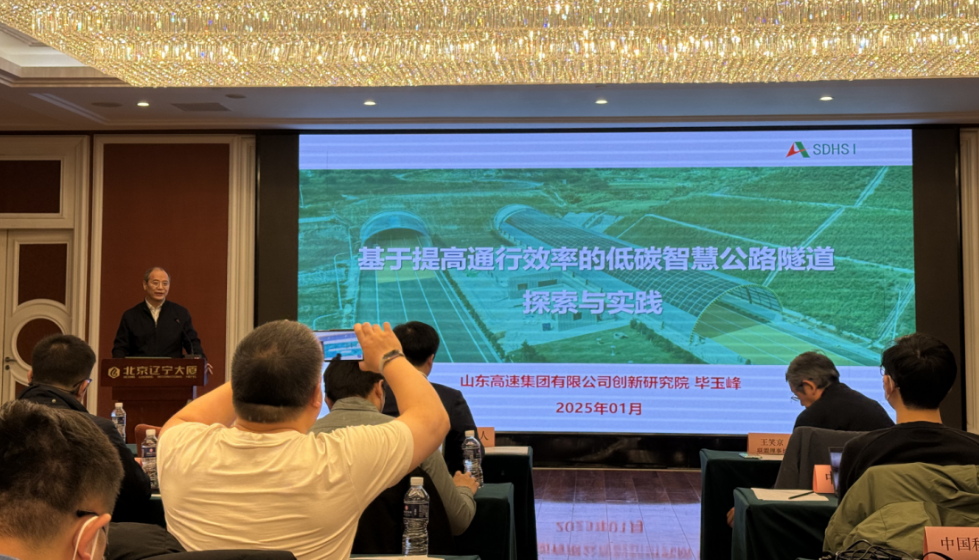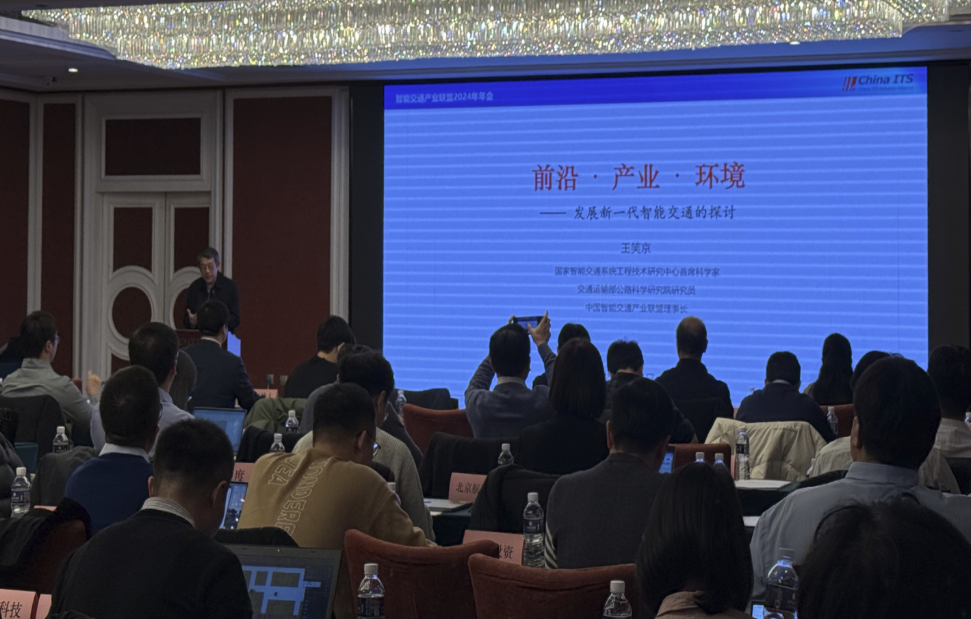The 2024 Annual Conference of the Intelligent Transportation Industry Alliance was successfully held in Beijing.
On January 21, 2025, the 2024 Annual General Meeting and Conference of the Alliance was successfully held in Beijing. More than 150 expert representatives from member units of the intelligent transportation industry, including the Highway Research Institute, Road Network Center, Tsinghua University, Beihang University, Water Transport Research Institute, China Classification Society, Institute of Software of the Chinese Academy of Sciences, North Security Center, China Academy of Information and Communications Technology, Huawei, ZTE, China Mobile, China Unicom, China Automotive Research Institute, Geely Automobile, Changan Automobile, Dongfeng Commercial Vehicles, Denso, Intel, Qualcomm, Baidu, Alibaba, NavInfo, AutoNavi, Hisense, Kylin Software, Neusoft Reach, COSCO Shipping, Shoufa Group, Surecom Technology, Jietong, Wanji, Chenggu Technology, Star Cloud Interconnect, Plus.ai, and Yikong Zhijia, attended the meeting. The conference focused on in-depth discussions around cutting-edge topics such as road network operation services, intelligent cockpits, human-computer interaction, low-carbon smart highways, and the future of intelligent transportation, jointly exploring the future development of intelligent transportation empowered by technology.

In the current era of rapid technological advancement, technology is being integrated into road network operation services at an unprecedented speed and depth. At the conference, Mr. Li Bin, Director of the Road Network Monitoring and Emergency Response Center of the Ministry of Transport, delivered a keynote speech titled "Empowering High-Quality Development of Road Network Operation Services with Technology." He pointed out that China's road network is vast, the growth momentum of vehicle ownership continues, and highway traffic volumes remain high. With the increase in traffic, factors such as concentrated holiday travel, severe weather, and traffic accidents have caused serious congestion on highways, with some sections experiencing major bottlenecks, severely impacting public travel. Additionally, as global climate change leads to more frequent extreme weather events, this poses new challenges for the safety management and operation of China's ultra-large-scale road network. Furthermore, significant changes have occurred in the intercity transportation structure of key regions, with travel patterns showing urbanization characteristics. Cross-regional highway travel remains at a high level, the task of reducing logistics costs while improving quality and efficiency is arduous, and the aging population is gradually becoming a notable feature. He suggested that, in response to the new changes in public travel and transportation demands, technologies such as artificial intelligence and big data analysis should be used to predict and mitigate major disaster risks in the road network, enhance road network operation control capabilities, and maintain high levels of service for road network accessibility and smoothness. By integrating new quality productivity, building technological innovation platforms and carriers, and establishing a new road network operation model of "professionalism + mechanisms + big data," technology can empower provincial and regional road network operation services.

Researcher Ma Cuixia from the Institute of Software, Chinese Academy of Sciences, delivered a keynote speech titled "Natural Human-Computer Interaction Empowering Intelligent Cockpits." From the perspectives of ergonomics and human-computer interaction, she explored the application and development of natural human-computer interaction technology in intelligent cockpits, particularly the new opportunities and challenges brought by autonomous driving technologies. She believes that the human-machine relationship is a crucial prerequisite for human-machine collaboration, and the current human-computer interaction in intelligent cockpits has entered a new phase of "AI + intelligent agents + embodied intelligence." The human-machine relationship, collaborative decision-making, and interaction efficiency optimization are key scientific and technological issues in natural human-computer interaction for intelligent cockpits. The human-machine relationship includes critical issues such as human-machine trust, mutual understanding, emotional regulation, and driving authority allocation. Human-computer interaction encompasses gesture recognition, multimodal interaction, and visual analysis, among others. Achieving mutual understanding between humans and machines, optimizing the human-machine relationship to calibrate trust, and designing multi-modal natural interactions are currently the core scientific challenges in natural human-computer interaction research for intelligent cockpits. Multi-channel integrated natural human-computer interaction strategies can empower human-centered cockpit design. Intelligent systems (cockpit-driving) based on natural human-computer interaction should become "understanding" personalized co-pilots that can comprehend, cooperate with, and support humans. They should not only focus on driving-related tasks but also consider non-driving-related needs (such as work and entertainment tasks), creating a "third living space." At the same time, only by adopting non-contact, high-sampling-rate, low-cost, and lightweight driver state perception systems (sensors, computing modules, and algorithms) can human-centered intelligent vehicles move out of the laboratory and achieve large-scale applications.

In addition, Mr. Bi Yufeng, Director of the Innovation Research Institute of Shandong Hi-Speed Group, delivered a keynote report titled "Exploration and Practice of Low-Carbon Smart Highway Tunnels Based on Improving Traffic Efficiency," sharing the practical achievements and experiences of Shandong Hi-Speed in the construction of low-carbon smart highway demonstration projects. Director Bi pointed out that current tunnel management and control face the following four major challenges: 1) Due to drastic changes in lighting and narrow spaces, vehicles require vehicles to decelerate, resulting in low operational efficiency—known as the "speed reduction at tunnels" issue; 2) Tunnel monitoring methods are singular, mostly based on single-point judgments, lacking multi-system data sharing and intelligent analysis; 3) The tunnel operation and maintenance environment is complex and high-risk, with limited internal space making emergency rescue difficult; 4) Tunnel electricity usage lacks refined management, especially for tunnel lighting, which consumes significant energy.To address these challenges, Shandong Hi-Speed proposed four major technical frameworks: "visual optimization, multi-dimensional perception, safety and disaster prevention, and green energy conservation." These include speed-maintaining tunnel passage technology based on human factors engineering, vehicle tracking and process reconstruction in complex environments of high-traffic tunnels, low-intrusion intelligent operation and emergency response technology for enhance efficiency and safety, and tunnel energy self-sufficiency technology based on source-load interaction. The research results of these technical systems have been successfully applied to the Jiwei Expressway (a key smart highway project under the Ministry of Transport's new infrastructure construction initiative). The driving speed in Jiwei Expressway tunnels has been increased to 120 km/h, improving tunnel traffic efficiency by over 20%. This initiative reduces carbon emissions by 9,600 tons annually and saves approximately 10.12 million yuan in energy costs. Additionally, it effectively reduces manual inspection costs, improves cleaning efficiency and safety, and lowers maintenance costs by 1.8 million yuan. The project's experience has been successfully deployed in tunnels on the Jiwei Expressway, Huyu Expressway, and Kunming's Northwest Third Ring Road, resulting in a 40% reduction in accident rates.

At the conference, the Alliance Secretariat reported on the work progress of the Alliance in 2024, including membership development, industrialization advancement, standardization efforts, and international and domestic exchanges and collaborations. Meanwhile, Mr. Wang Xiaojing, Chairman of the Alliance, delivered a keynote speech titled "Frontiers, Industry, Environment: Exploring the Development of Next-Generation Intelligent Transportation." He shared recent developments in intelligent transportation systems (ITS) abroad and their implications for the future of ITS in China. Over the past three years, the themes of the ITS World Congress have focused on automated transportation (vehicles), sustainable development, connected and cooperative transportation, digitalization, and integrated transportation (logistics), which are currently hot topics in the international ITS community. Senior management in the ITS field is paying more attention to digitalization and AI, future cities and future transportation, sustainable transportation, and intelligent integrated transportation. He also introduced the future ITS development trends in developed countries such as Japan and the United States. For example, Japan's next-generation ITS services focus on "reducing the burden of travel," "strengthening connections with various socio-economic activities," and "rapid and resilient risk response," with greater emphasis on "planning road and ITS development from the perspective of overall social and economic development" and "the hierarchical structure and future of next-generation ITS." The United States' next-step ITS strategic priorities include safety, climate and sustainable development, economic strength and global competitiveness, transformative development, equity, technology transfer, and deployment. Currently, developed countries are more focused on applying new technologies and achieving benefits from the perspective of overall social and economic development. Although perspectives on future intelligent transportation development vary among countries, there is consensus on the following points: 1) Next-generation digital technologies and AI will have a significant impact on transportation development models; 2) The main development focus: human-centered and data-driven; 3) Representative foundational application technologies: the Internet of Everything and artificial intelligence; 4) Planning future digital and intelligent transportation systems from the perspective of sustainable development and societal progress. Additionally, he shared some cutting-edge transportation technologies to watch, including "breakthroughs in quantum navigation technology, bringing GPS-free navigation closer to reality," "France's world-first test of a space laser for secure downlink communication between satellites and ground stations," and "Wi-Fi achieving long-distance transmission using the new WiLo method." He also proposed viewing the future of intelligent transportation from a broader perspective, noting that after more than 30 years of development, intelligent transportation has evolved into a form led by technologies such as AI, big data, cloud computing, and full connectivity, driven by application model transformation and commercial benefits. In the future, the application of new quality productivity in next-generation intelligent transportation will bring changes to production relations, labor, labor objects, and labor relations, necessitating the planning of future ITS development from the perspective of society and the economy.
